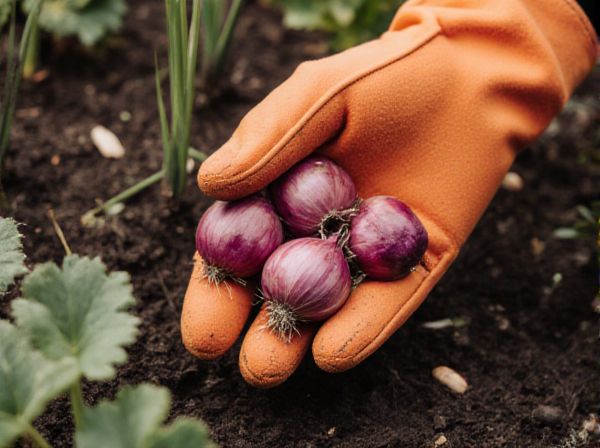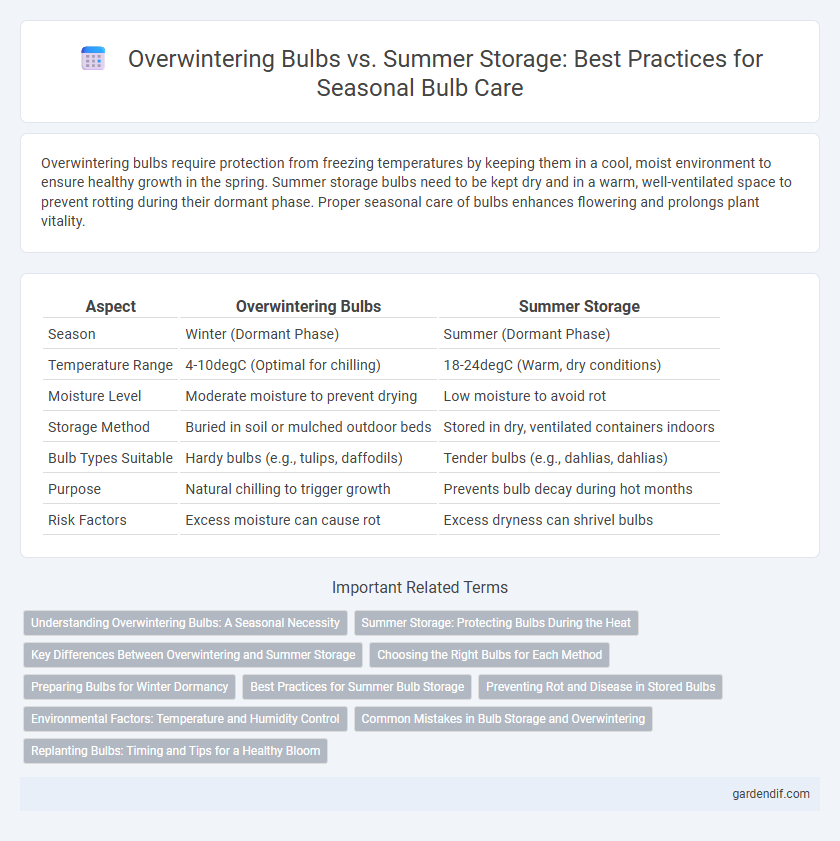
Overwintering bulbs vs Summer storage Illustration
Overwintering bulbs require protection from freezing temperatures by keeping them in a cool, moist environment to ensure healthy growth in the spring. Summer storage bulbs need to be kept dry and in a warm, well-ventilated space to prevent rotting during their dormant phase. Proper seasonal care of bulbs enhances flowering and prolongs plant vitality.
Table of Comparison
| Aspect | Overwintering Bulbs | Summer Storage |
|---|---|---|
| Season | Winter (Dormant Phase) | Summer (Dormant Phase) |
| Temperature Range | 4-10degC (Optimal for chilling) | 18-24degC (Warm, dry conditions) |
| Moisture Level | Moderate moisture to prevent drying | Low moisture to avoid rot |
| Storage Method | Buried in soil or mulched outdoor beds | Stored in dry, ventilated containers indoors |
| Bulb Types Suitable | Hardy bulbs (e.g., tulips, daffodils) | Tender bulbs (e.g., dahlias, dahlias) |
| Purpose | Natural chilling to trigger growth | Prevents bulb decay during hot months |
| Risk Factors | Excess moisture can cause rot | Excess dryness can shrivel bulbs |
Understanding Overwintering Bulbs: A Seasonal Necessity
Overwintering bulbs requires maintaining proper soil moisture and insulation to protect against freezing temperatures and ensure healthy spring growth. Unlike summer storage, which involves drying and storing bulbs in a cool, dry place to prevent rot, overwintering bulbs remain planted or carefully mulched outdoors during winter. Understanding these seasonal care methods optimizes bulb survival and maximizes flowering potential for subsequent growing seasons.
Summer Storage: Protecting Bulbs During the Heat
Summer storage of bulbs is essential for protecting tender species from prolonged heat and dryness, which can cause desiccation or premature sprouting. Proper techniques include lifting bulbs after foliage dies back, curing them in a dry, airy place, and storing in breathable containers at temperatures around 50-60degF (10-15degC). Maintaining low humidity and avoiding direct sunlight during summer storage prevent rot and ensure bulbs remain healthy for successful overwintering and future growth cycles.
Key Differences Between Overwintering and Summer Storage
Overwintering bulbs require a cold, dormant period to survive winter, typically stored in cool, moist environments to mimic natural conditions. Summer storage involves keeping bulbs dry and warm after flowering to prevent rot and promote healthy sprouting in the next season. Key differences include temperature control, moisture levels, and timing, with overwintering focusing on cold dormancy and summer storage prioritizing dryness and warmth.
Choosing the Right Bulbs for Each Method
Selecting bulbs with inherent hardiness is crucial for successful overwintering, favoring varieties like tulips, daffodils, and crocuses that thrive in cold soil. Bulbs requiring summer storage, such as dahlias and gladiolus, demand dry, warm conditions to prevent rot and maintain viability. Understanding each bulb's natural dormancy cycle ensures optimal storage and robust blooming across seasons.
Preparing Bulbs for Winter Dormancy
Overwintering bulbs requires carefully preparing them for winter dormancy by ensuring they are fully dry and free from soil to prevent rotting. Summer storage, in contrast, involves keeping bulbs in a cool, dark, and ventilated environment to maintain their viability without sprouting prematurely. Properly managing temperature and humidity during both processes enhances bulb survival and supports healthy growth in the following season.
Best Practices for Summer Bulb Storage
Overwintering bulbs require cool, dry conditions to prevent rot and mold, typically stored at temperatures between 35degF and 50degF with good air circulation. For summer storage, bulbs like dahlias and gladioli should be cleaned, allowed to dry thoroughly, and kept in a well-ventilated, frost-free area at around 60degF to 70degF. Proper labeling and periodic inspection ensure bulbs remain healthy and ready for replanting in the next growing season.
Preventing Rot and Disease in Stored Bulbs
Overwintering bulbs requires planting them in well-drained soil with adequate mulch to prevent rot and fungal diseases during cold months. For summer storage, bulbs must be cured and kept in a dry, ventilated environment with low humidity to avoid moisture buildup that fosters decay. Monitoring stored bulbs regularly for signs of mold or soft spots ensures early intervention and maintains bulb health for the next growing season.
Environmental Factors: Temperature and Humidity Control
Overwintering bulbs require consistent cold temperatures between 35degF and 50degF with high humidity levels around 70-80% to prevent desiccation and dormancy disruption. Summer storage demands warmer temperatures of 60degF to 75degF and lower humidity below 50% to inhibit mold growth and bulb decay. Effective temperature and humidity control during these periods is crucial for maintaining bulb viability and ensuring successful seasonal growth.
Common Mistakes in Bulb Storage and Overwintering
Common mistakes in bulb storage and overwintering include exposing bulbs to fluctuating temperatures, which can cause premature sprouting or rot. Improper drying or insufficient ventilation often leads to mold growth, significantly reducing bulb viability. Storing bulbs in overly damp or sealed containers disrupts natural dormancy, resulting in poor growth during the following season.
Replanting Bulbs: Timing and Tips for a Healthy Bloom
Overwintering bulbs involves planting them in the fall to establish roots before winter, ensuring robust spring blooms, while summer storage requires digging up bulbs after the growing season and keeping them dry until replanting. Ideal replanting time for overwintered bulbs is early fall, allowing sufficient chilling periods, whereas summer-stored bulbs should be replanted once the temperature cools to prevent rot and encourage growth. Proper soil preparation, consistent moisture, and avoiding late-season planting optimize bulb health and vibrant blooming.
Overwintering bulbs vs Summer storage Infographic

 gardendif.com
gardendif.com